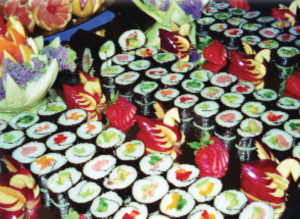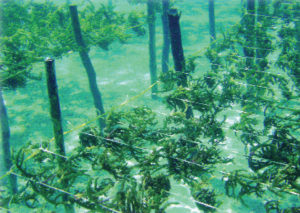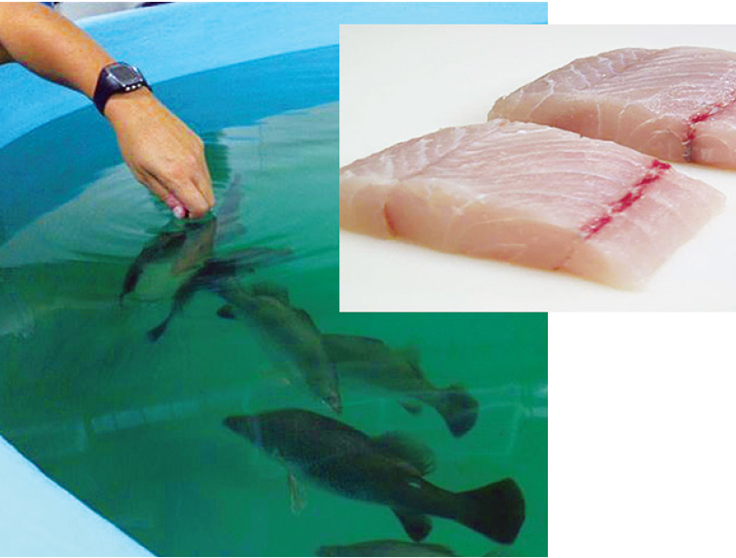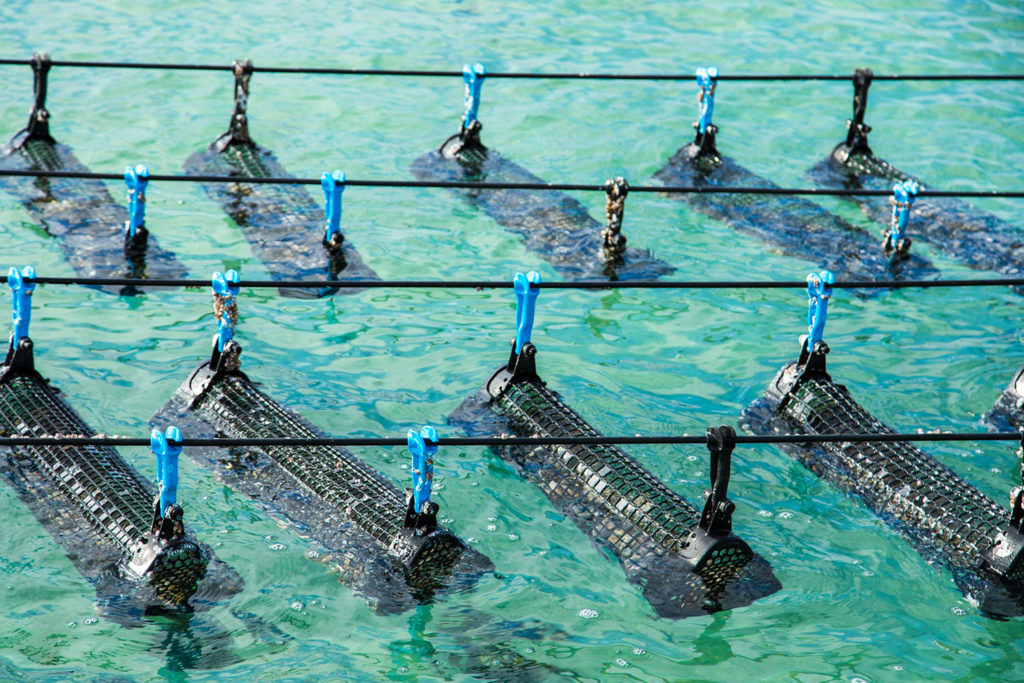Seaweeds have value as soil additives and fertilizers
People have been eating fresh and sun-dried seaweeds for health purposes in oriental countries for thousands of years. However, in recent years, many new compounds with medicinal values have been identified in different types of seaweeds. Interestingly, most of these pharmaceutical compounds and nutraceuticals come from traditionally edible seaweeds like nori, kombu, wakame and hiziki.
Diverse applications

The annual value of cultivated, managed and wild-harvested seaweeds exceeds $6.0 billion, with 87 percent of that amount derived from aquaculture. With worldwide production of approximately 14 billion sheets, the most valued of the maricultured seaweeds is the red alga (Porphyra) popularly known as “nori” in Japan. It is a source of food for humans throughout the world, although it is primarily cultivated in China, Japan, and South Korea.
Other economically important edible seaweeds include Laminaria (kombu), Undaria (wakame), Hizikia (hiziki) and Caulerpa (sea grapes). Additional seaweed species are industrial sources of carrageenans, alginates and agars. These important polysaccharides are used in the food, textile, paint, biotechnological and biomedical industries.
Seaweeds have significant value in agriculture as soil additives, fertilizers and seaweed meals. There is also renewed interest in using seaweeds as biological nutrient removal systems in the integrated aquaculture of finfish and crustaceans. The bioremediation potential of several Porphyra, Gracilaria and Laminaria species has been assessed for open water and land-based systems.
Medical uses
Many seaweeds and their polysaccharides have demonstrated antibacterial, antiviral, and antitumor effects. Recently, some seaweeds have shown antioxidant and anti-HIV potential. The sulfated polysaccharide Carraguard, now in clinical trials in Africa, appears to be a safe and cost-effective microbiocide that may reduce the transmission of HIV and possibly other sexually transmitted infections, according to the Population Council.
Porphyra is rich in dietary fiber, contains 25 to 50 percent protein, more vitamin C than oranges, and trace minerals. Seventeen types of free amino acids have been reported in Porphyra. Its very high taurine levels have been associated with reducing levels of cholesterol. Porphyra and Undaria are promising seaweeds for preventing cardiovascular disease.
Consumption of Undaria pinnatifida can decrease blood pressure in humans. Enteromorpha, Monostroma and Caulerpa are other edible seaweeds with several health benefits. Recent epidemiological studies suggested a link between the consumption of seaweeds and a reduction in prostrate, colorectal, and breast cancers. A variety of antioxidant compounds including polyphenols have been identified in several brown seaweeds.
Antiviral, antitumor

The SeaHealth project was recently launched in France to demonstrate the benefits of seaweeds’ antioxidant substances to prevent atherosclerosis and cancer. Antioxidant properties have been reported from Grateloupia filicina, an edible red alga called limu in Hawaiian culture that is widely eaten in Hawaii, Japan, Korea, and other countries.
Sulphated polysaccharides from red algae inhibit viral action. Both the Herpes virus (containing DNA) and HIV (containing RNA) are inhibited by sulphated polysaccharides. Aqueous extracts of many red seaweeds are active against retroviruses. Carrageenan is cointernalized into infected cells with Herpes Simplex Virus, thus inhibiting the growth of the virus.
Many marine algae have shown antitumor activities. Significant activity against E. coli was found in the brown algae Scytosiphon lomentaria (69.8 percent inhibition), Lessonia nigrescens (60 percent), Laminaria japonica (57.6 percent) and Sargassum ringgoldainum (46.5 percent). Five brown and four red algae have shown appreciable antitumor properties against meth-A-fibrosarcoma.
Other uses
Polysaccharides from brown and red seaweeds have several other uses. Earlier, alginates were used mainly to increase the viscosity of liquids and for dental filling. Today, alginates are being tailor-made by chemical selection or enzymatic treatment. Alginates require calcium, potassium, or sodium for gelation and have limited ranges of textures. Propylene glycol alginate solutions suspend particulates and are used as secondary emulsifiers and flow modifiers for salad dressings and fruit beverages.
Alginates are also used to encapsulate chemical, microbial, plant, and animal cells that are subsequently used as desired metabolite producers. Consumption of sodium alginates and low-molecular sodium alginates reduces cholesterol levels. Brown algal polysaccharides have anticoagulant, antiviral, and anti-inflammatory actions. In clinical trials, simple extracts of Undaria pinnatifida have been potent inhibitors of HIV.
Culture continues
A few companies have successfully demonstrated tank cultivation of Porphyra for the production of specific nutraceuticals. Canada-based Ocean Nutrition and Nori Tech, an Israeli company, are developing tailor-made Porphyra to meet specific requirements. In India, Pepsico started large-scale cultivation of carrageenophyte seaweed.
With uses for seaweed continuing to expand, the demand for various seaweeds and their products will likely increase in the near future, thereby supporting the need for wider development of pharmacological aquaculture.
(Editor’s Note: This article was originally published in the August 2005 print edition of the Global Aquaculture Advocate.)
Now that you've reached the end of the article ...
… please consider supporting GSA’s mission to advance responsible seafood practices through education, advocacy and third-party assurances. The Advocate aims to document the evolution of responsible seafood practices and share the expansive knowledge of our vast network of contributors.
By becoming a Global Seafood Alliance member, you’re ensuring that all of the pre-competitive work we do through member benefits, resources and events can continue. Individual membership costs just $50 a year.
Not a GSA member? Join us.
Authors
-
Dinabandhu Sahoo
Marine Biotechnology Laboratory
Department of Botany
University of Delhi
Delhi, India -
Charles Yarish
Department of Ecology and Evolutionary Biology
University of Connecticut
1 University Place
Stamford, Connecticut 06901-2315 USA
Tagged With
Related Posts

Responsibility
A look at integrated multi-trophic aquaculture
In integrated multi-trophic aquaculture, farmers combine the cultivation of fed species such as finfish or shrimp with extractive seaweeds, aquatic plants and shellfish and other invertebrates that recapture organic and inorganic particulate nutrients for their growth.

Intelligence
Adding flavor complexity to farmed barramundi
Organoleptic attributes such as flavor and aroma are among the most important factors that influence consumer acceptability and demand for fish products. Consumers have identified farmed fish as less complex and lacking “sealike” or “sea-fresh” flavors and aromas.

Responsibility
A look at various intensive shrimp farming systems in Asia
The impact of diseases led some Asian shrimp farming countries to develop biofloc and recirculation aquaculture system (RAS) production technologies. Treating incoming water for culture operations and wastewater treatment are biosecurity measures for disease prevention and control.

Responsibility
Advancing the ecosystem services of aquaculture
The Nature Conservancy was inactive in aquaculture until new program leader Robert Jones joined. His focus is on the positive outcomes of responsible aquaculture.


